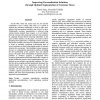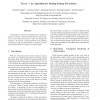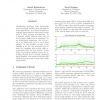ICDM
2006
IEEE
15 years 7 months ago
2006
IEEE
In frequent geographic pattern mining a large amount of patterns is well known a priori. This paper presents a novel approach for mining frequent geographic patterns without assoc...
ICDM
2006
IEEE
15 years 7 months ago
2006
IEEE
Recently, there has been considerable interest in computing strongly correlated pairs in large databases. Most previous studies require the specification of a minimum correlation...
116
Voted
ICDM
2006
IEEE
15 years 7 months ago
2006
IEEE
In this paper, we propose a novel and general approach for time-series data mining. As an alternative to traditional ways of designing specific algorithm to mine certain kind of ...
128
Voted
ICDM
2006
IEEE
15 years 7 months ago
2006
IEEE
The immense explosion of geographically referenced data calls for efficient discovery of spatial knowledge. One critical requirement for spatial data mining is the capability to ...
107
click to vote
ICDM
2006
IEEE
15 years 7 months ago
2006
IEEE
On the Web, where the search costs are low and the competition is just a mouse click away, it is crucial to segment the customers intelligently in order to offer more targeted and...
ICDM
2006
IEEE
15 years 7 months ago
2006
IEEE
When monitoring sensory data (e.g., from a wearable device) the context oftentimes changes abruptly: people move from one situation (e.g., working quietly in their office) to ano...
ICDM
2006
IEEE
15 years 7 months ago
2006
IEEE
Many 0/1 datasets have a very large number of variables; however, they are sparse and the dependency structure of the variables is simpler than the number of variables would sugge...
ICDM
2006
IEEE
15 years 7 months ago
2006
IEEE
In this paper, we present the foundations for mining frequent tri-concepts, which extend the notion of closed itemsets to three-dimensional data to allow for mining folksonomies. ...
ICDM
2006
IEEE
15 years 7 months ago
2006
IEEE
Classification problems with functionally structured input variables arise naturally in many applications. In a clinical domain, for example, input variables could include a time...
ICDM
2006
IEEE
15 years 7 months ago
2006
IEEE
Under-sampling is a class-imbalance learning method which uses only a subset of major class examples and thus is very efficient. The main deficiency is that many major class exa...



